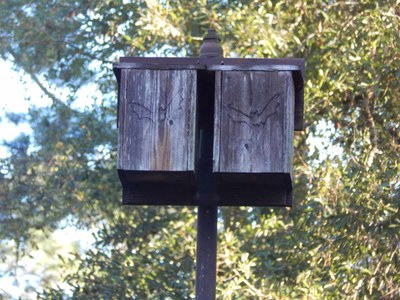The Instinct to Migrate
October 2020
By Ranger Amy
The cooler weather brings back memories from when I was a child. I used to "build camp" and pretend to migrate around the backyard as the weather changed. As an adult, I watch migrating animals with a hint of envy and imagine life with no boundaries or passports.
Migratory animals, such as Mexican free-tailed bats, will leave their summer roosts with the arrival of cold weather and head south. Migratory bats have the freedom to change their surroundings, but with the freedom of flight lurks an unseen danger.
Migrating bats
 The arrival of the first cold front had me checking a bat box in the park to see if our seasonal migratory residents have checked in. Lots of squeaking and fresh droppings tell me that the migration has started.
The arrival of the first cold front had me checking a bat box in the park to see if our seasonal migratory residents have checked in. Lots of squeaking and fresh droppings tell me that the migration has started.
Several types of bats call East Texas home, but Mexican free-tailed bats are fun to watch since they fill up the park’s bat boxes during their migration.
Life on the wing
 Mexican free-tail bats are about the size of your thumb and their wingspan is the size of your outstretched fingers. The ability to fly ensures their survival. They can reach roosting sites, cave ceilings and the undersides of bridges, where no predators can reach them.
Mexican free-tail bats are about the size of your thumb and their wingspan is the size of your outstretched fingers. The ability to fly ensures their survival. They can reach roosting sites, cave ceilings and the undersides of bridges, where no predators can reach them.
A couple nights ago, I was in my backyard with a flashlight trying to see flying squirrels on an oak tree. Instead of finding the squirrels, I was surprised to find bats! My flashlight was lighting up the sky and attracting moths. A bat quickly and precisely flew in and out of the beam of light, catching dinner.
With the aid of echolocation, think submarines and dolphin clicks, bats can precisely nab a flying insect such as a moth, beetle, or flying ant from the air. Many of these insects are pests to different crops. Depending on the size of a summer bat colony these bats can eat over two tons of insects in one night!
Population decline
Although Mexican free-tailed bats can live to be 18 years old, they are facing a population decline. Often the danger for bats is human disturbance of colonies and the caves they roost in, but pesticides are also a big problem.
All summer long bats are gobble up insects and store body fat to help them survive migration, especially newborn baby bats. Each insect they eat, or the milk they drink when nursing, contains small amounts of pesticides that accumulate in their body fat. When it’s time to migrate, they burn their fat deposits and lethal doses of pesticides enter their bloodstream. It’s ironic that lurking within their freedom to fly away and migrate is the danger of death.
Help the bats!
Bats are a natural pest control that we benefit from, but their lives and existence is precious in its own regard. How can we help them?
Every penny we spend can either hurt or help our natural world. One way to help is to buy organic food products.
I may never have the freedom of flight the way bats do, but I always enjoy watching them and know the world is a better place with them in it. Therefore, I will help them in every way possible.
